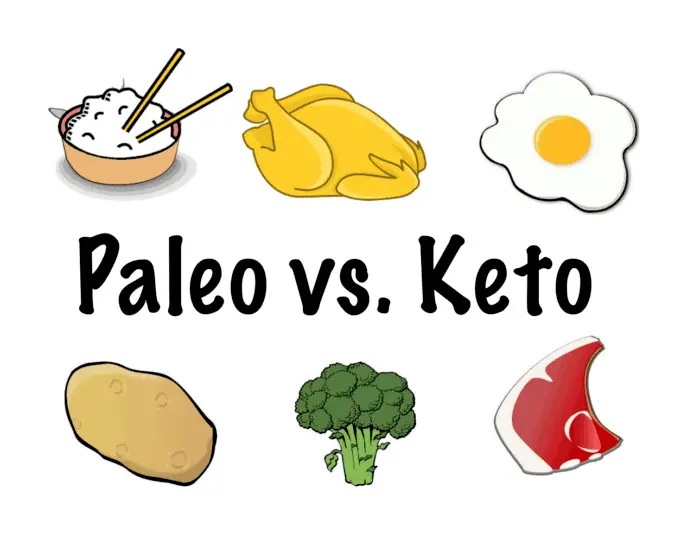Introduction
Paleo and keto diets have gained significant popularity in recent years, each claiming to offer unique health benefits. While both diets emphasize whole foods and limit certain food groups, they differ in their macronutrient composition, food choices, and underlying principles. In this comprehensive guide, we’ll explore the differences between the Paleo and keto diets, helping you understand their respective approaches to nutrition and health.
Paleo Diet
What is the Paleo Diet?
The Paleo diet, short for the Paleolithic diet, is based on the premise of eating foods that our ancestors consumed during the Paleolithic era, such as meat, fish, fruits, vegetables, nuts, and seeds.
Principles of the Paleo Diet
Emphasis on whole, unprocessed foods.
Elimination of grains, legumes, dairy, refined sugar, and processed foods.
Focus on nutrient-dense foods rich in protein, healthy fats, fiber, vitamins, and minerals.
Foods to Eat on the Paleo Diet
Grass-fed meats
Wild-caught fish and seafood
Eggs
Fruits and vegetables
Nuts and seeds
Healthy fats like olive oil, coconut oil, and avocado
Keto Diet
What is the Keto Diet?
The ketogenic (keto) diet is a high-fat, low-carbohydrate diet designed to induce a state of ketosis, where the body primarily burns fat for fuel instead of carbohydrates.
Principles of the Keto Diet
Drastic reduction in carbohydrate intake (typically less than 50 grams per day).
Moderate protein intake and high-fat consumption to promote ketone production.
Transitioning the body into ketosis, a metabolic state characterized by elevated ketone levels in the blood.
Foods to Eat on the Keto Diet
Meat and poultry
Fatty fish
Eggs
Full-fat dairy products
Nuts and seeds
Healthy oils like olive oil, coconut oil, and MCT oil
Low-carb vegetables
Differences Between Paleo and Keto
Macronutrient Composition
Paleo
Moderate protein, moderate to high fat, and moderate to high carbohydrate intake from fruits and vegetables.
Keto
Moderate protein, high fat, and very low carbohydrate intake to induce ketosis.
Carbohydrate Restrictions
Paleo
No strict carbohydrate limits, but focuses on whole, unprocessed sources of carbohydrates like fruits and vegetables.
Keto
Strict carbohydrate restriction to achieve and maintain ketosis, typically less than 50 grams of net carbs per day.
Emphasis on Ketosis
Paleo
Does not specifically aim to induce ketosis but emphasizes whole foods and nutrient density.
Keto
Primary goal is to achieve and sustain ketosis for fat burning and metabolic benefits.
Dairy and Legumes
Paleo
Eliminates dairy and legumes due to their potential to cause inflammation and digestive issues.
Keto
Allows some full-fat dairy products in moderation but restricts legumes due to their carbohydrate content.
Flexibility
Paleo
Allows for more flexibility in food choices, as long as they align with the principles of whole, unprocessed foods.
Keto
Requires strict adherence to carbohydrate limits to maintain ketosis, limiting food choices to low-carb options.
Benefits and Considerations
Weight Loss
Both Paleo and keto diets may promote weight loss due to their focus on whole foods and restriction of processed foods and sugars.
Blood Sugar Control
Keto diet may be more effective for blood sugar control and insulin sensitivity due to its very low carbohydrate intake and promotion of ketosis.
Sustainability
Paleo diet may be more sustainable long-term for some individuals due to its flexibility and inclusion of a wider variety of foods.
Keto diet may be challenging to maintain over time due to its strict carbohydrate restrictions and potential for side effects like the “keto flu.”
Athletic Performance
Paleo diet may be beneficial for athletes due to its emphasis on whole, nutrient-dense foods and adequate carbohydrate intake from fruits and vegetables.
Keto diet may be effective for endurance athletes once fully adapted to ketosis, but high-intensity activities may suffer initially due to limited glycogen availability.
Frequently Asked Questions (FAQs)
Which Diet is Better for Weight Loss Paleo or Keto?
Both Paleo and keto diets can be effective for weight loss, but the best diet for you depends on your individual preferences, health goals, and lifestyle factors.
Can You Combine Paleo and Keto Principles?
Yes, some people choose to combine elements of both diets, following a “Paleo-keto” approach that emphasizes whole foods, healthy fats, and moderate protein while keeping carbohydrate intake low enough to promote ketosis.
Is One Diet Safer Than the Other?
Both Paleo and keto diets can be safe and healthy when followed properly and balanced with nutrient-dense foods. However, individuals with certain medical conditions or dietary restrictions should consult with a healthcare professional before starting any new diet plan.
Are Cheat Meals Allowed on Paleo or Keto?
Some people choose to incorporate occasional cheat meals or “treats” into their Paleo or keto diets, but it’s essential to be mindful of portion sizes and frequency to avoid derailing progress or disrupting metabolic goals.
Can Paleo or Keto Diets Help Manage Certain Medical Conditions?
Both Paleo and keto diets have been studied for their potential therapeutic effects on various medical conditions, including obesity, type 2 diabetes, metabolic syndrome, and neurological disorders. However, individual responses may vary, and it’s essential to work with a healthcare professional for personalized guidance.
Conclusion
Paleo and keto diets offer distinct approaches to nutrition and health, each with its own set of principles, benefits, and considerations. While Paleo focuses on whole, unprocessed foods and moderate carbohydrate intake, keto prioritizes high-fat, very low-carb eating to induce ketosis. Ultimately, the best diet for you depends on your individual preferences, health goals, and lifestyle factors. Experimentation and flexibility may be key to finding the dietary approach that works best for your body and promotes optimal health and well-being.
- The UK’s Most Prestigious Wellness Destination Launches New Cleanse - April 24, 2024
- 7 Nutrition and Health Benefits of Okra - April 24, 2024
- Can You Cure Your Acne with Apple Cider Vinegar? - April 24, 2024

